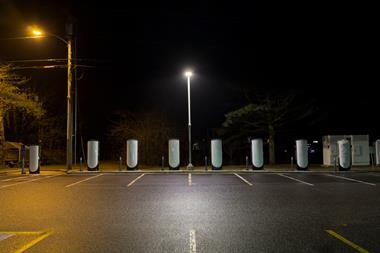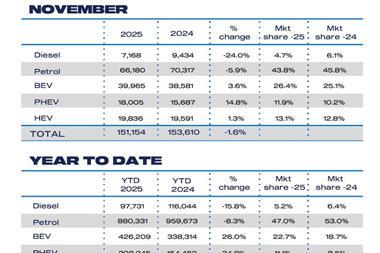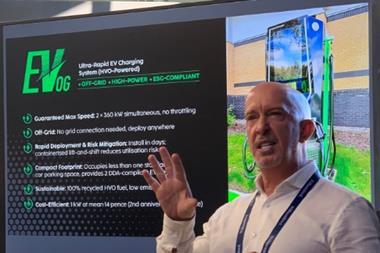As of 1 January 2022:
- there were 28,375 public electric vehicle charging devices available in the UK
- of the total devices available, 5,156 were rapid chargers
Compared to 1 October 2021:
- available devices increased by 2,448, an increase of 9%
- rapid devices increased by 233, up 5%
- there was an increase in total and rapid devices across all regions of the UK

The number of public electric vehicle charging devices has increased by 37% - a total of 7,600 devices in the past year, according to the latest Department of Transport quarterly statistics.
The number of rapid devices increased by 33%, with an additional 1,276 public devices, during the same period. The statistics reveal there is an uneven geographical distribution of charging devices within the UK. Some UK local authorities have bid for UK Government funding for charging devices, and others have not. The Department for Transport (DfT) says most of the provision of this infrastructure has been market-led, with individual charging networks and other businesses (such as hotels) choosing where to install devices.
Change in public charging devices, per region, 1 January 2022 compared to 1 October 2021; percentage and number of devices
| Region | Total devices change | Rapid devices change |
|---|---|---|
| United Kingdom | 9.4% (+2448) | 4.7% (+233) |
| North East | 6.4% (+59) | 0.4% (+1) |
| North West | 4.6% (+79) | 4.3% (+17) |
| Yorkshire and the Humber | 7.2% (+96) | 4.9% (+18) |
| East Midlands | 9.7% (+137) | 7.5% (+26) |
| West Midlands | 7.3% (+125) | 6.0% (+28) |
| East of England | 7.3% (+122) | 6.1% (+23) |
| London | 16.4% (+1292) | 4.3% (+30) |
| South East | 6.2% (+212) | 4.5% (+34) |
| South West | 6.0% (+112) | 5.5% (+23) |
| Wales | 6.1% (+61) | 5.6% (+9) |
| Scotland | 5.2% (+140) | 3.4% (+23) |
| Northern Ireland | 3.9% (+13) | 4.8% (+1) |
The statistics show that London and Scotland had the highest level of charging provision per 100,000 of population, with 102 and 52 devices per 100,000 respectively. In comparison, the average provision in the UK was 42 per 100,000.
Northern Ireland had the lowest level of charging device provision in the UK, with 18 devices per 100,000, followed by the North West and Yorkshire and the Humber with 24 and 26 devices per 100,000 respectively.
Scotland had the highest rate of rapid device provision of 12.9 rapid devices per 100,000, while the average provision in the UK was 7.7 per 100,000. Rapid device provision was lowest for Northern Ireland and Wales, with 1.2 and 5.3 rapid devices per 100,000 respectively.
Total and rapid public charging devices per 100,000 of population by UK region
| Region | Devices per 100,000 population | Rapids per 100,000 population |
|---|---|---|
| United Kingdom | 42 | 7.7 |
| North East | 36 | 8.6 |
| North West | 24 | 5.6 |
| Yorkshire and the Humber | 26 | 7.0 |
| East Midlands | 32 | 7.7 |
| West Midlands | 31 | 8.3 |
| East of England | 29 | 6.4 |
| London | 102 | 8.0 |
| South East | 39 | 8.6 |
| South West | 35 | 7.9 |
| Wales | 33 | 5.3 |
| Scotland | 52 | 12.9 |
| Northern Ireland | 18 | 1.2 |
All regions across the UK saw an increase in total charging devices between October 1, 2021 and January 1, 2022. London had the greatest increase at 16.4%, while Northern Ireland and the North West had the smallest increases at 3.9% and 4.6% respectively. London also had the greatest increase in absolute number of devices at 1,292 devices, contributing to more than half of the increase in devices across the UK.
The latest data reveals that ‘rapid’ charging devices - classified as those whose fastest connector is rated at 25kW and above - have increased in every region in the UK. The smallest percentage increase in the number of rapid devices was in the North East at 0.4%. East Midlands had the largest percentage increase in rapid devices at 7.5%, corresponding to an increase of 26 rapid devices.
‘Total devices’ represent publicly available charging devices at all speeds, including: slow, fast, rapid and ultra-rapid.
The DfT report said the number of available devices can fluctuate for a range of reasons. Increases likely reflect the installation of new devices, while owners and operators can choose to temporarily or permanently decommission or replace devices. Charging devices can also be unavailable due to faults, maintenance or other restrictions in the area where they are located.

































No comments yet